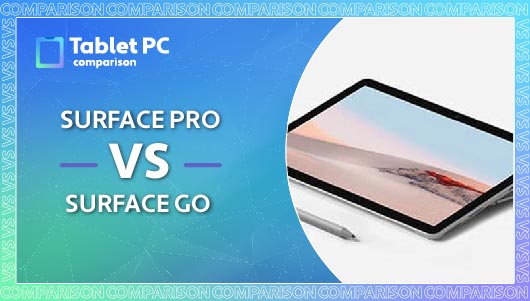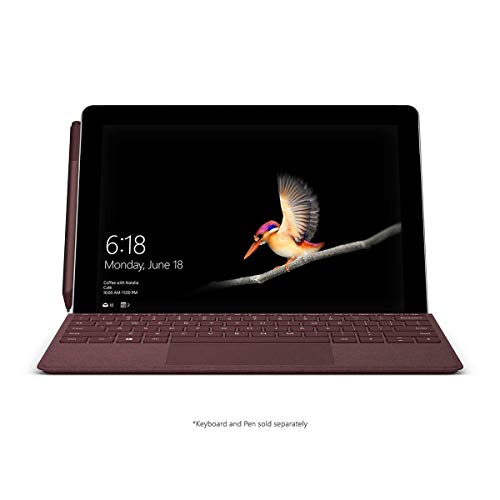Last Updated on November 30, 2021
Surface Pro vs Surface Go
We wanted to see whether the newer Surface Go was an improved version of the Surface Pro

Tablet PC Comparison is reader-supported. When you buy through links on our site, we may earn an affiliate commission.
The Surface Pro was Microsoft’s answer to a versatile tablet that can be used as both a tablet and a laptop. You can use this device for all sorts of multitasking jobs, with it being built for entertainment, work, and creativity.
With such an impressive device being on the market, you wouldn’t necessarily think that Microsoft would have to improve on the Surface Pro. However, the newer Surface Go has everyone’s head spinning due to its improvements in the way of both portability and affordability.
Today we’ll be looking at both the Surface Pro and the Surface Go and pitting them against each other to determine which is the clear winner. Is it worth it to pay almost double the price for the Surface Pro, or does the Surface Go excel beyond its predecessor?
- Standing screen display size: 12.3 Inches
- Screen Resolution: 2736 x 1824
- Processor: 8032
- RAM: 128 GB LPDDR4x
- Hard Drive: 128 GB flash_memory_solid_state
- Graphics Coprocessor: Intel Iris Plus Graphics
- Chipset Brand: Intel
- Card Description: Integrated
- Wireless Type: Bluetooth
- Average Battery Life (in hours): 10.5 Hours
- Standing screen display size: 10 Inches
- Screen Resolution: 1800 x 1200
- Processor: 1.6 GHz 8032
- RAM: 64 GB
- Hard Drive: 64 GB Flash Memory Solid State
- Graphics Coprocessor: Intel HD Graphics 615
- Chipset Brand: Intel
- Card Description: Integrated
- Graphics Card Ram Size: 64 GB
- Wireless Type: 802.11abg
- Average Battery Life (in hours): 3 Hours
- MicroSDXC card reader
- Mini DisplayPort
- Surface Connect port
- One USB Type-A port
- Headphone jack
- MicroSDXC card reader
- Mini DisplayPort
- One USB-C port
- 3.5mm headphone jack
- Intel Core m3/128GB SSD/4GB RAM
- Intel Core i5/128GB SSD/8GB RAM
- Intel Core i5/256GB SSD/8GB RAM
- Intel Core i5/256GB SSD/8GB RAM (LTE)
- Intel Core i7/256GB SSD/8GB RAM
- Intel Core i7/512GB SSD/16GB RAM
- Intel Core i7/1TB SSD/16GB RAM
- Intel Pentium Gold 4415Y/64GB eMMC/4GB RAM
- Intel Pentium Gold 4415Y/128GB SSD/8GB RAM
- Great battery life
- High screen resolution
- Powerful graphics and pixel density
- More expensive
- Only one USB port
- Small and portable
- High-quality build that compares well to Surface Pro
- Low price
- A smaller keyboard is difficult to use
- No full-size USB ports
- Not as quick as Surface Pro
A Quick Look Into Surface Pro vs. Surface Go
Surface Go is smaller and less expensive than the Pro alternative, with a 10-inch screen as opposed to the 12.3-inch screen of the Surface Pro. Don’t be fooled; however, thinking that the Go is only a smaller clone of the Pro. There are plenty of differences between these two.
As with any smaller price point, some sacrifices had to be made with the Surface Pro. The processor is of lower wattage and the memory storage is altered. However, this shouldn’t be taken as the Surface Go is a complete write-off – there are many advantages that come with this modest device.
You can use both Surface Go and Surface Pro with the majority of the same accessories as well, so you can use them with similar functionality. If you opted for both of the devices, you’d be able to use these accessories interchangeably.
Both have the infamous kickstand built into the screen for your convenience, and that’s not the only quality that these two devices share. Let’s take a deeper dive into both the similarities and differences of the Surface Pro and Surface Go so that you can choose the best for you.
Comparing The Features
The features of a device are the most important – they’re what help you decide which option to choose. Below we look at the key features for both Surface Pro and Surface Go to see how they hold up against one another.
Connectivity
Perhaps the most important feature of a tablet, connectivity which allows you to use your tablet with other devices and accessories. The Surface Pro has the following ports for excellent connectivity:
As you can see, you can use the Surface Pro with a number of different devices to enhance your work experience. The Type-A USB port also gives you more options to connect things with regular USB wires.
On the other hand, Surface Go also has a respectable number of connections, listed below:
Not as much choice as the larger option, but still nothing to grumble about. Plus, the smaller size of the Surface Go makes as many connectivity options impressive in its own right. The USB-C port is slightly inconvenient, but an adapter is not expensive to purchase separately.
Screen
In terms of the screen size, Surface Pro wins with a 2.3-inch advantage against the Surface Go. Some will value a larger screen more than others if they find it easier to read off of or watch entertainment from.
The resolution and pixel density are also higher with the Surface Pro, with 2,736 x 1,824 pixels overall. This means that every inch of the screen has 267 pixels, making everything clear-cut and precise.
However, the screen for the Surface Go doesn’t fall short greatly compared to this, with 1,800 x 1,200 pixels for the display. The aspect ratio is 3:2 and the glass has been coated with Gorilla Glass 3.
There’s a 10-point touch feature that advances your usability, should you ever need to use every single finger on the screen at once. We’ve never been in the situation, but it’s nice to know that it’s there as a safety net.
Both the Surface Pro and Surface Go have the popular kickstands on the back of the screen so that you can use them both in the same way. Surface Pro has better size and resolution, but Surface Go is still impressive if you’d prefer better portability.
Configurations and Storage
There are seven variations of the Surface Pro on the market to choose from, which are listed below with the core components they come equipped with:
With so many configurations to choose from, you can customize your tablet to suit your needs best. This is a stark contrast from the configurations available for the Surface Go, which only has two at the time of writing. These are listed below:
While Surface Pro wins in terms of core components and number of configurations at the moment, it’s also worth noting that the Surface Pro has been released longer than the Surface Go.
So, in the future, we anticipate more configurations to come from the Surface Go. For now, though, there is more choice from Surface Pro.
Accessories
Perhaps the most exciting accessory that can be used with both the Surface Pro and the Surface Go is the Surface Pen. This accessory is an optional additional purchase, but it can be used with both tablets which is a great benefit for people looking for an inexpensive option for a digital creative outlet.
The Surface Keyboards are not interchangeable between these tablets; however, so you’ll need to purchase the keyboard for the specific tablet you have. The keyboards all come with a built-in touchpad.
Surface Pro has three different colored keyboards to choose from while Surface Go only has one color option. Both Surface Pro and Surface Go also work with the Surface Mobile Mouse, which is wireless so won’t take up one of your connectivity points.
Camera
Both Surface Pro and Surface Go have the same front and rear-facing cameras, down to the megapixels. For the front-facing camera, they opt for 5 megapixels, and the rear-facing camera boasts 8 megapixels.
Considering the fact that Surface Go needed to omit some of its features to lower the price point, we think that the rear-facing camera could have been left out of the design. The additional price could then have been put on something else to make it more impressive.
However, the rear-facing camera is a smart decision from Microsoft to allow a better comparison between the Surface Go and the iPad Air, and other market-leading tablets.
Prices
The price points for these tablets are probably where the main differences lie, as the Surface Pro is considerably more expensive than the Surface Go.
Starting at $799 for the Intel Core m3/128GB SSD/4GB RAM and ending at $2,399 for the Intel Core i7/1TB SSD/16GB RAM, the Surface Pro has an impressive price range to suit many budgets.
On the other hand, the Surface Go starts at $399 for the Intel Pentium Gold 4415Y/64GB eMMC/4GB RAM and ends with the Intel Pentium Gold 4415Y/128GB SSD/8GB RAM at $549.
Benefits and Drawbacks
Surface Pro Benefits
Surface Pro Drawbacks
Surface Go Benefits
Surface Go Drawbacks
Final Comparison
Overall, both the Surface Pro and Surface Go compare well to one another. However, there is a clear winner in our opinion. Surface Pro excels in terms of screen size, resolution, configurations, and accessories.
However, we want to stress that this does not mean that the Surface Go is not worth it if you wanted a tablet with a lower price. A tablet for half the price of the Surface Pro might make the difference in features worth it for you.
The camera and connectivity features for both of these tablets also don’t have much difference between them, so you can use Surface Pro and Surface Go in similar ways for work and educational purposes.
The only issue with the smaller screen might be down to using the tablet for entertainment. If you wanted to use the Surface Pen for design, a smaller screen might also leave you with limited space and options.
You should compare the additional features that the Surface Pro comes with compared to the high price jump to determine whether the additional cost is justified to you or not.


